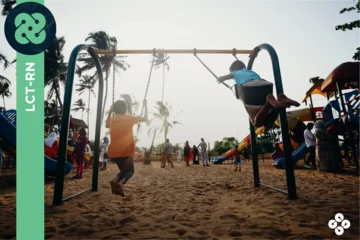The Ecology of Childhood: How our Changing World Threatens Children’s Rights
By Barbara Bennett Woodhouse 2020 New York University Press
Review by Shirley Russ
In her book The Ecology of Childhood, Barbara Bennett Woodhouse tells the compelling story of how she initially set out to conduct an ethnographic study comparing children’s well-being in the Cedar Key area of Florida, where there appear to be few social safety nets, and the village of Scanno in the Abruzzo Region of Italy, with its much more generous child welfare policies. However, the Great Recession in 2008 had major impacts on the lives of children in both regions, transforming her study from a comparison of policies to one which instead revealed the power of global forces to threaten the well-being of all children. The author lays out how the direct and indirect effects of the recession and subsequent reactions, including economic stimulus packages in the US, and strict austerity measures in Italy, had an immediate and lasting impact on children and their families, and brought home how closely the fortunes of different countries are tied together. In short, policies developed and enacted in the US affect children in the US, but also affect children in Italy. Globalization is real and tangible and, Woodhouse argues, a force that must be addressed for children to thrive.
Woodhouse documents a detailed study of the microsystems – e.g. family and peer groups where children’s daily lives unfold; the mesosystems where the microsystems overlap and intersect – e.g. in faith-based schools in local communities; and the exosystems that encircle children’s worlds even though children do not enter them – e.g. parents work place, housing markets, demonstrating how forces in each of these systems impact children’s sense of identity and well-being. What she has to say is not encouraging, with a disturbing number of trends placing ever increasing pressures on the family unit and on children, including climate change, mass migration, job losses and the technological revolution to name but a few.
The situation appears so acute, and so much at risk of entering a bigger downward spiral, that the author argues a global movement is urgently needed to safeguard children’s well-being. She views the most sensible place to start as the universal adoption of the UN Convention on the Rights of the Child, a Children’s Right treaty that has not currently been adopted by the US. Those who are hesitant about the UN Rights approach frequently cite concerns about the potential erosion of the role of the family as protector, provider and nurturer of children; while supporters of the approach emphasize the profound nature of the global changes occurring in society, and the potential threats to children that families alone would have little power to counteract. In this book, despite making a strong case, I do not think the author will quite succeed in either allaying the fears of the first group, or providing the second with a strong enough argument to win the day. For example, Italy has already adopted the UN Convention on Children’s Rights, but it is unclear what impact that might have had on their response to the great recession. However, she does provide excellent examples of the power of youth and children’s voices, and the need to have them heard and considered by decision-makers at all levels.
The rights agenda is not all that Woodhouse has to offer. In her previous writings she has developed the idea of “ecogenerism,” a child-centered and environmentally-informed perspective on events. Its guiding philospophy regards a commitment to the welfare of future generations as the mark of a just and sustainable society. This leads on to proposals for a child-centered value system as a measure of how well a society is truly functioning. Here, the author is on solid and familiar ground. In Chapter 5, she explores two current crises largely attributable to exosystemic factors: the sharp decline in birth rates in developed countries, and the migration of young people from rural to urban areas. Her arguments are well developed, balanced and compelling. Do we really want a future where young people are afraid to have children for fear of not being able to support them, or one where younger generations must leave behind older in search of ever-moving jobs and affordable housing, severing family and social ties in the process? These are real and immediate issues affecting almost all families worldwide, and the author’s sincerity in making the case for the need to address them urgently makes for particularly strong writing.
Woodhouse’s ecogenerism idea resonates strongly with life course approaches to health development. Both are “future-leaning” in their orientation, arguing that investments early on pay dividends later in ways that are good not just for some but for the whole of society. As stewards of the environment, we must look to the future, considering not just the immediate impact of our actions, but the likely impact 10, 50 even 100 years from now. Children benefit from spending time in nature in ways that we are only beginning to fully understand, and one of the most powerful incentives for finding the best ways to interact with our environment is to leave behind a world where children can thrive. This “intergenerational perspective” has yet to permeate the political arena in a meaningful way, and this book goes a long way towards making the argument for an “ecogenerative” or “life course” lens to be applied to all contemporary decision-making.
In the final chapter, Woodhouse returns to a “small is beautiful” approach, urging grassroots actions that incorporate the principles of children’s rights, advancing child-friendly communities, and building a world fit for children. This book has much to offer anyone interested in children’s rights, and an ecological approach to the study of children’s well-being. It is an excellent and informative resource for anyone studying – or teaching – on child development, and will be sure to spark much classroom debate.




